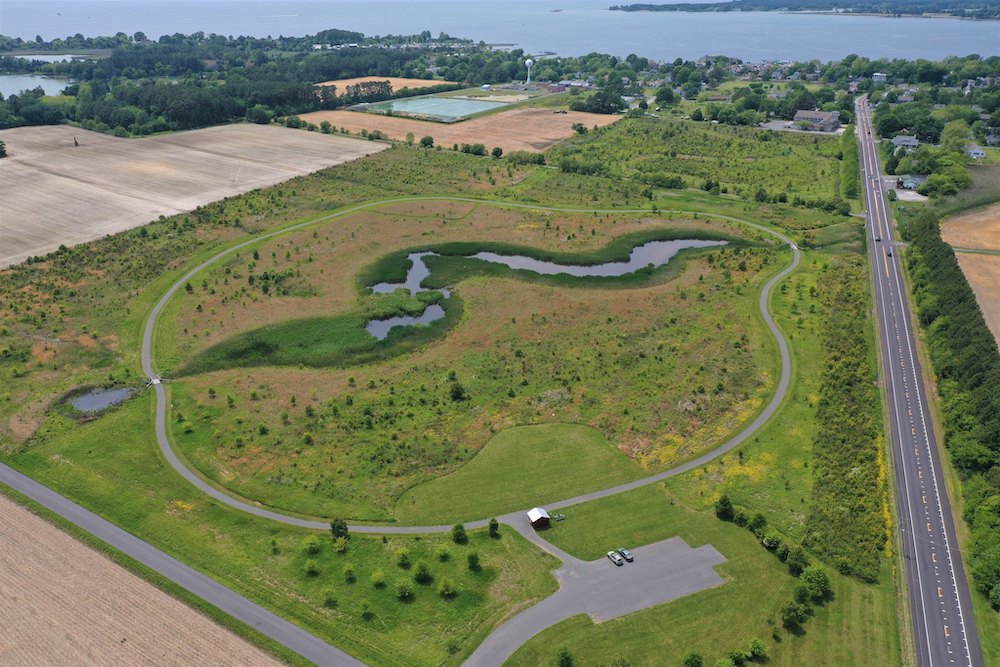
Along with summer swimming comes ShoreRivers Bacteria Monitoring season. It is advised that people not swim 24-48 hours after a major rain.

Nonpartisan Education-based News for Talbot County Community
by ShoreRivers


Along with summer swimming comes ShoreRivers Bacteria Monitoring season. It is advised that people not swim 24-48 hours after a major rain.
The Spy Newspapers may periodically employ the assistance of artificial intelligence (AI) to enhance the clarity and accuracy of our content.

Originally farmland, Oxford Conservation Park was designated to become a subdivision before Talbot County’s former Director of Parks and Recreation, Preston Peper, Talbot County Engineer Bill Wolinski, and a team of community stakeholders worked together to plan and create a public park where anyone from the community could go to walk and enjoy nature. Now this warren of wetlands and meadows is enjoyed every day by birders, walkers, photographers, and visitors of all ages. Soon it will offer even more.
In 2023, the Friends of Oxford Conservation Park volunteer group approached Eastern Shore Land Conservancy with their concerns over the condition of the park’s habitat, asking for ESLC’s help. ESLC’s Enhanced Stewardship Manager Larisa Prezioso then began working with Talbot County Parks and Recreation, Washington College’s Natural Lands Project, and the Friends of Oxford Conservation Park to help enhance the existing habitat in need of maintenance and restoration. In addition to the collaborative efforts to keep present grasslands healthy and forests diverse, the partnership worked together to pursue funding for the completion of the initial park plan. Activating this plan will result in converting the park’s remaining thirty acres from row crops to passive recreational grasslands and trails. As of this summer, Washington College’s Natural Lands Project, which has converted 80 sites and thousands of acres of marginal cropland across the Shore into diverse native meadows, wetlands, and forests, has received funding from the Department of Natural Resources Atlantic and Coastal Bays Trust Fund to initiate the expansion starting in the spring of 2025.
“This project is a great collaboration between our project, the Eastern Shore Land Conservancy, Talbot County, and the Friends of Oxford Conservation Park,” said Kathy Thornton, Natural Lands Project Field Technician, noting that each entity has certain resources they can contribute to the effort. “Together, this makes for a strong project where we can manage existing habitat, create new habitat, and sustain a long-term maintenance plan.”
“Conservation does not happen in a bubble,” said Dan Small, the Natural Lands Project Coordinator and Associate Director of Natural Land Stewardship at the Washington College Center for Environment & Society. “By leveraging resources and enthusiasm from grant funds, non-profits, volunteer groups, and County government, we’re able to turn public space into a sanctuary for both people and wildlife,” said Small.
The new 30-acre mix of native meadows will feature tree plantings and native short stature grasses and wildflowers not found in the existing habitat, which is currently dominated by native tall grasses. A network of walking trails will connect to and double the length of trails across the park. And new educational signage will teach visitors about the many ecosystem services that these diverse native meadows provide, including flood mitigation, prevention of soil erosion, and improved water quality within the Chesapeake Bay watershed.
Climate change resilience, expanded trails, and educational opportunities will be of huge benefit to the public, but the real beneficiaries of this new project will be the wildlife. Once abundant on the
Eastern Shore, low-lying early successional habitats like grasslands, fallow fields, meadows and prairies have become increasingly rare. The rarer the meadows, the rarer the unique suite of wildlife that depends upon them—species like field sparrows, woodcocks, warblers, turtles, salamanders, and fireflies. Small and Thornton’s main focus is creating habitat to support another meadow-lover: Northern Bobwhite quail. A few quail have been sighted at the park recently and the team is hopeful that this new habitat expansion will ultimately support a healthy breeding population.
When supporting early successional species like quail, the overall footprint of the habitat is crucial. Adding these next thirty acres will create larger habitat areas that can support more individuals. Small and Thornton explain, “Most grassland birds prefer to establish territories and nests away from wooded edges, so meadows with larger interior space away from forest edges is beneficial.” More space also bolsters population growth of threatened birds because there are more nooks and crannies to hide nests, making it harder for predators to find them. No child playing hide and seek would choose to hide in a small manicured front yard over a wide and rambling weedy backyard garden. Now the OCP quail coveys are finally getting the sprawling warren of a garden they deserve. And the grassy paths winding through the new meadow’s wildflowers and warm-season grasses will encourage people to get lost in the glorious thick-of-it too, finding all sorts of flora and fauna surprises along the way.
“Truly, this work would not have happened without the passion and advocacy of the Friends of Oxford Conservation Park,” said Prezioso. “Having a dedicated and engaged group of volunteer citizens not only provides such an asset to the park’s long-term care, but also demonstrates that
having ecological, passive-recreational spaces is something that’s valuable to our community, and worth advocating for.”
Established in 1990, Eastern Shore Land Conservancy’s mission is to conserve, steward, and advocate for the unique rural landscape of Maryland’s Eastern Shore, forever a special place of diverse and abundant natural resources and thriving rural communities.
The Spy Newspapers may periodically employ the assistance of artificial intelligence (AI) to enhance the clarity and accuracy of our content.
by Bay Journal


The Perdue AgriBusiness soybean processing plant in Salisbury, MD, added machinery without a permit, leading to more air pollution, according to the Maryland Department of the Environment.
Two major agricultural companies ramped up operations recently on Maryland’s Eastern Shore, and the environment paid a price, according to the Maryland Department of the Environment.
One case involves the agency’s second-largest cash penalty in its history while the other has reopened a long-running pollution saga that local environmentalists hoped had been resolved.
Perdue’s plant, situated a couple blocks away from its parent company’s headquarters, extracts the oil from soybeans to be used in cooking, among other uses.
Perdue applied for a permit in 2017 but withdrew the application the following year after MDE indicated it would require additional review. The company went ahead anyway with the installation of the new machinery in September 2017, followed by a second round in May 2019, according to the settlement agreement.
After the plant’s expansion, the hexane emissions, state officials say, exceeded the 40-ton annual threshold to be considered a new “major source” of pollution, MDE alleged. Hexane is a volatile organic compound, a major ingredient in ground-level ozone that can worsen an array of breathing problems from asthma to emphysema, experts say.
MDE records show annual VOC emissions increased at the facility by 28% from 2017 to 2019, from 246 tons to 315 tons.
“Everyone must follow the rules which are in place to keep Marylanders safe. When Perdue failed to comply, it was the community who suffered the undue burden, so there must be meaningful penalties,” said Attorney General Anthony Brown. “I am glad that Perdue has accepted responsibility and will be investing in the surrounding neighborhoods moving forward.”
The settlement calls for Perdue to pay an $8 million fine to the state. The only larger civil penalty in MDE’s history was the $29 million settlement in 2018 with Volkswagen over the auto manufacturer’s installation of “defeat devices” on certain vehicles, aimed at circumventing emissions tests.
Perdue also must install $3.5 million in pollution-reduction measures at the plant, including electrifying diesel-fired equipment, and contribute $400,000 to Salisbury for a tree planting campaign in areas with poor canopy coverage.
In separate press statements, the two sides left a muddled picture about when and how the problem came to light. MDE’s legal complaint says that agency staff and Perdue representatives “met at various times” to discuss the cause of the emission increases. It wasn’t until correspondence on April 11, 2022, however, that Perdue “finally admitted” it had installed the equipment without a permit, MDE alleged in a legal complaint.
Meanwhile, Perdue spokeswoman Kate Shaw said in a statement that “The discrepancy was discovered in May of 2020, as part of our air permit renewal process.” Her statement doesn’t indicate who discovered the discrepancy or whether state inspectors were aware of it at the time. She added, “We take full accountability for what occurred. The individuals who did not reapply for the permit are no longer with the company.”
When asked for clarification via email, Bill See, another Perdue spokesman, replied, “Our original statement stands on its own.”
In a separate case, MDE charges that Darling Ingredients, owner of the Valley Proteins poultry rendering plant in Dorchester County, has violated its October 2022 consent decree. Under that settlement, Darling Ingredients agreed to pay $540,000 to the state while fixing wastewater and stormwater problems at the troubled plant.
“I would say this facility is in no better shape than it was in 2021 when we filed the lawsuit,” said Matt Pluta, the Choptank Riverkeeper and director of riverkeeper programs at ShoreRivers, one of the environmental groups whose lawsuit triggered the decree. “In fact, it’s probably gotten worse.”
A few months after the settlement was signed, MDE renewed the plant’s discharge permit, allowing a nearly four-fold increase in the amount of wastewater it can release into the Transquaking River, a nutrient-impaired Chesapeake Bay tributary. Environmentalists had pushed MDE to impose tougher limits and not let the company expand until showing it could meet them, but the agency didn’t do so.
Problems have piled up since that approval. MDE inspectors say they uncovered 51 violations of the decree’s requirement to maintain at least 2 feet of freeboard – the distance from the surface of the wastewater to the top of the holding pits. In May, MDE announced plans to fine Darling $15,000.
The Texas-based company formally contested the fine, arguing that all the exceedances fell under an exception in the decree for lagoon levels to rise because of heavy rainfall.
MDE also contends that the plant has been hauling away production waste from the lagoons without going through the complete treatment process. Farmers use the material, known as “dissolved air flotation,” to fertilize their fields. But in adjoining Caroline County, the practice has sparked an outcry from neighbors about foul odors and prompted county commissioners to enact a moratorium on its storage.
Darling representatives have told the state they believe their current permit allows the hauling to continue. Ongoing upgrades to the wastewater treatment plant, required as part of the 2022 decree, will substantially reduce, if not eliminate, such hauling, they say.
“We have responded to the MDE and share its commitment to resolving this issue through the established MDE process,” Darling spokeswoman Jillian Fleming said in a statement.
The agency notified Darling in June that it was referring the hauling matter along with other recent violations to the state Attorney General’s Office.
By Jeremy Cox
The Spy Newspapers may periodically employ the assistance of artificial intelligence (AI) to enhance the clarity and accuracy of our content.
by Henley Moore

A few months ago, The Nature Conservancy released a report that could solve one of the major obstacles facing climate adaptation: finding the money to do things.
Many towns, particularly on the Eastern Shore, are facing an increasingly long list of infrastructure projects, but funding those expensive undertakings has become harder. That’s where TNC’s report, SEAFARE, could make a huge difference to those municipalities.
Through workshops with various stakeholders, including local residents, environmental justice leaders, and government officials, the report identifies barriers like complicated funding processes. It provides a toolkit to help decision-makers improve access to those dollars.
The Spy’s Dave Wheelan spoke to Human Sharif, TNC’s climate adaptation manager, to understand more.
This video is approximately five minutes in length. For more information about this report please go here.
The Spy Newspapers may periodically employ the assistance of artificial intelligence (AI) to enhance the clarity and accuracy of our content.

Eastern Shore Land Conservancy is pleased to welcome Kate Rumbaugh to the organization’s board of directors. Rumbaugh’s 30+ years of experience in public policy and government affairs on the federal, state, and local levels will support ESLC’s growing portfolio of policy work. “Kate’s deep expertise in policy, advocacy, and communications is an important addition to the Eastern Shore Land Conservancy Board of Directors,” commented ESLC President and CEO Steven Kline. “As we seek to increase our engagement with decision makers, Kate’s voice, expertise, and bipartisan approach to problem solving will be invaluable.”
“ESLC’s work in the policy arena can really complement and grow our conservation efforts overall,” commented Rumbaugh. “Sharing information with public policy makers so that they know our concerns is like having a neighbor understand you, understand what’s important to you, and understand how we can all work together in the same community serving the same people.”
Jim Mullin, chair of the ESLC board of directors added, “We are thrilled to have Kate join us on the board, where she has jumped right in to the work. Building a board with expertise that reflects the full scope of our work is essential. Kate’s policy and communications skills will improve the effectiveness of Eastern Shore Land Conservancy.”
Currently the Head of Government Affairs for Doordash, Rumbaugh is an alum of the University of Maryland, and has also studied at the Prince of Wales’s Business & Sustainability Programme at The University of Cambridge Institute for Sustainability Leadership, and the Conflict Resolution workshop at the Program on Negotiation at Harvard Law School. Rumbaugh first became familiar with the Chesapeake Bay as a child—boating, fishing, waterskiing, and crabbing with her father when he was stationed there. “Coming over here to be closer to the Bay and away from a busy city is something that I’ve wanted to do for some time,” Rumbaugh commented, “I finally found the right place to do it.”
Now happily settled in St. Michaels, she is “tremendously honored to have been appointed to the board,” where she can learn more about local land conservation on both an organizational and personal level. “I see the fragility of the Eastern Shore. If left to our own devices I’m not sure everybody would share the need or understanding for preserving it. It’s good to be able to help advance that notion and create better understanding for the need to preserve. There are always competing pressures—the growth of communities versus preserving communities. We’re in an area of growth that makes those competing priorities difficult. Focus and attention in this space is increasingly more important than ever.”
Established in 1990, Eastern Shore Land Conservancy’s mission is to conserve, steward, and advocate for the unique rural landscape of Maryland’s Eastern Shore, forever a special place of diverse and abundant natural resources and thriving rural communities.
The Spy Newspapers may periodically employ the assistance of artificial intelligence (AI) to enhance the clarity and accuracy of our content.
by ShoreRivers

Celebrate the end of summer with ShoreRivers at the Shaw Bay Raft-Up Concert from 3–6 pm on Saturday, September 7. The Eastport Oyster Boys will be making their 21st appearance and the Wye River Band will be back for their fifth at this free concert, which aims to raise funds and awareness for clean water efforts on Maryland’s Eastern Shore.
This annual benefit concert is a must for mariners of all kinds. Boat in to Shaw Bay near the mouth of the Wye River and then join the floating raft up on your dinghy, paddle board, or kayak to enjoy a front row seat to the live concert. Visit shorerivers.org/events to find sponsorship opportunities, a map of nearby locations from which to launch your vessel, and to sign up to receive text updates on the event.
While the concert is free, donations are welcome, with all proceeds helping to promote the clean water initiatives of ShoreRivers on the Miles and Wye rivers and in Eastern Bay. ShoreRivers is grateful for the generous sponsorship of John & Jill Murray, St. Michaels Marina, Bosun’s Marine, and Leigh Family & Cosmetic Dentistry.
ShoreRivers is a nonprofit organization dedicated to protecting Maryland’s Eastern Shore waterways through science-based advocacy, restoration, education, and engagement. Our local waterways are polluted by excess nutrients and sediment that run off of urban, suburban, agricultural, and commercial land. ShoreRivers is dedicated to implementing real solutions through programs and projects to improve the health of these waterways. To learn more, please visit shorerivers.org.
To sign up to receive Shaw Bay Raft-Up Concert updates, text shawbayconcert to 443.302.3844. Event questions may be directed to Courtney Leigh at [email protected].
##
The Spy Newspapers may periodically employ the assistance of artificial intelligence (AI) to enhance the clarity and accuracy of our content.
by Spy Desk

Residents of Queen Anne’s County are invited to attend an upcoming Solar Visioning Info Session to learn about utility-scale solar development and participate in facilitated discussions. This session aims to educate the public on regional utility-scale solar development and provide a platform for community dialogue on various aspects of solar projects. The insights gathered from this community conversation will inform local leaders, government officials, and the research team about resident perceptions of solar development. The discussion will help shape the following:
Comprehensive planning, including solar overlay maps
Strategies for landowners to negotiate with solar developers
Strategies for communities to negotiate with solar developers.
Your participation will help the University of Maryland (UMD) Extension and public officials understand how to proactively engage communities in planning for solar energy land use. Recognizing that many rural landowners may be approached by developers, our goal is to enhance the solar siting process by incorporating the voices and priorities of local and county government and community members. A summary report will be provided to all participants later in the summer.
This event is organized in partnership with Queen Anne’s County Government, MDA’s Maryland Agricultural Conflict Resolution Service, UMD’s Agriculture Law and Education Initiative, and UMD Extension. UMD Extension provides Maryland residents with the highest quality of public service, distinguished educational programming, and cutting-edge research through the dissemination of unbiased research-based educational information.
The upcoming Solar Visioning Info Session is free to attend, but registration is required. For more information and to register, visit go.umd.edu/QASolar. Register by August 12, 2024 to secure a dinner meal and to receive a gift valued at $25 when you attend the meeting.
Solar Visioning Info Session
Date: August 26, 2024 Time: 5:30-8:30 PM
Location: Chesapeake College, HEC 1000 College Circle, Wye Mills, MD 21679
The Spy Newspapers may periodically employ the assistance of artificial intelligence (AI) to enhance the clarity and accuracy of our content.
by The Spy Desk


Queen Anne’s County Achieves Significant Land Preservation Milestone
Queen Anne’s County is proud to announce that the County’s preserved agricultural land now totals 90,343 acres, pending the settlement of an additional 1,830 acres. This achievement results from the combined efforts of several programs dedicated to land preservation.
Key contributors to this milestone include:
The Queen Anne’s County Commissioners have made land preservation a top priority in recent years. In 2024, over $1 million was dedicated to the Maryland Agricultural Land Preservation Foundation program, which, after the state match, resulted in a total contribution of over $5 million towards easement acquisition.
“Land preservation is not just about protecting our natural resources; it’s about preserving our heritage and ensuring a sustainable future for generations to come. By safeguarding our open spaces and agricultural lands, we are maintaining the character and beauty of Queen Anne’s County, supporting our local economy, and contributing to larger environmental goals. Our commitment to these efforts reflects our dedication to our community’s well-being and our environment’s health. I am proud of our strides and remain committed to continuing this important work.” Said Jim Moran, County Commission President
These efforts align with the state’s “30 by 30” goal, which is consistent with President Biden’s executive order to conserve at least 30% of the country’s lands and waters by 2030.
“As of today, the County has preserved 43% of the agricultural zoned land. The County has not only met the 30% goal by 2030 but also the 40% goal by 2040 16 years ahead of schedule!” said Donna K. Landis-Smith, Queen Anne’s County Soil Conservation.
“For 55 years, Queen Anne’s Conservation Association has supported keeping Queen Anne’s County the rural gem that it is. The County’s commitment in preserving its farms and forests – and preserving 40% of it – highlights that commitment. QACA applauds Queen Anne’s County landowners who want to preserve their farms, the Commissioners and State for helping to fund the effort, and Mrs. Donna Landis-Smith for this exceptional achievement. We now look forward to reaching the 50% goal soon.” Said Jay Falstad, Executive Director of Queen Anne’s Conservation Association
An additional round of offers from the Maryland Agricultural Land Preservation Foundation will be announced in August. With this next round, Queen Anne’s County has the potential to secure an additional 1,409 acres once funding is available.
To learn more about the Queen Anne’s County Soil Conservation District, visit www.qac.org and search “Soil Conservation.”
To view the preserved land in Queen Anne’s County broken into categories found in the 2020 Comprehensive Plan, visit https://gis.qac.org/qac272/index.html?viewer=QAC_Property_Viewer.QAC_Property_Viewer
*To view the map that is associated with this release, visit https://www.qac.org/DocumentCenter/View/20838/Preserved-Land-as-of-July-2024 These numbers are current as of July 2024.
The Spy Newspapers may periodically employ the assistance of artificial intelligence (AI) to enhance the clarity and accuracy of our content.
by ShoreRivers

On Sunday, September 15, ShoreRivers will host its 20th Ride for Clean Rivers—a chance for cyclists to ride the beautiful back roads of Talbot and Queen Anne’s counties in support of the organization’s work for thriving rivers cherished by all Eastern Shore communities.
Riders of all ages and levels are welcome to register for fully supported Metric Century (62-mile), 35-mile, or 20-mile routes. All routes begin and end at Chesapeake College in Wye Mills and include SAG support from Queen Anne’s County Amateur Radio Club, and rest stops with food and drink from Sprout.
Staggered group send-offs at 8am and 9am will include a police escort across Route 50. Upon returning to the college campus, riders and volunteers will enjoy a boxed lunch from Sprout and beer from Ten Eyck Brewery. Participants are also encouraged to join teams and create their own fundraising pages to boost support for their ride from others.
ShoreRivers extends special thanks to these partners: Chesapeake College, Sprout, Bike Doctor Kent Island, Ten Eyck Brewing Company, TriCycle & Run, as well as volunteers from the Talbot Skipjacks 4-H Club, and Queen Anne’s County Amateur Radio Club.
All proceeds from this event support ShoreRivers’ science-based advocacy, restoration, education, and engagement programs. Registration prices will increase as the event nears, so sign up now! To register as a rider or sponsor, visit shorerivers.org/event/rideforcleanrivers2024. Any questions can be directed to Lindsey at [email protected].
ShoreRivers protects and restores Maryland’s Eastern Shore waterways through science-based advocacy, restoration, education, and engagement. `shorerivers.org
The Spy Newspapers may periodically employ the assistance of artificial intelligence (AI) to enhance the clarity and accuracy of our content.
by Steve Parks


Painting by Russell Jewell
Eighteen artists participated in the exhibit that ran through the end of the Plein Air fest on July 20. The show and sale at ESLC headquarters on Washington Street was mounted, in part, by way of a grant by Bruce Wiltsie, who has partnered with the Avalon Foundation since the start of Plein Air Easton. He has just been inducted into the PAE Hall of Fame for, as the event program stated, “years of support for the many ways that art can underscore the vital importance of conservation of our land and the beauty that surrounds us.”
The participating artists were Jill Basham, Tim Beall, Zufar Bikbov, Hiu Lai Chong, Lisa Egeli, Martin Geiger, Stephen Griffin, Joe Gyurcsak, Charlie Hunter, Debra Huse, Russell Jewell, Mick McAndrews, Charles Newman, Daniel Robbins, Mark Shasha, John Brandon Sills, Mary Veiga and Stewart White.
Some of the paintings are along the lines of what you may have viewed (or purchased) at the festival, including Debra Huse’s lavish brushstroke-textured “Historic Beauty” of trees bending over river’s edge and pointing toward a puff-clouded sky. But several others reminded me personally of the farm I was raised on in the ’50s and ’60s on Dutchman’s Lane, virtually next door to where I live now in Easton Club East. One-hundred acres of that farm are being developed into a Four Seasons 55-and-up community. (Full disclosure: My parents sold the farm in the ’70s.)
I remember a time when much of the waterfront acreage in Talbot County was tilled as farmland harvested for corn, wheat, rye and soybeans. Most of that land is now occupied by grand waterview estates, many like the ones hosting the annual “Meet the Artists” party which opens Plein Air Easton. I have no quarrel with that as those former agricultural fields with a view – maybe even a beach – were not much more accessible to trespassers than these myriad private waterfront properties, now best seen by boat or by rare – but often generous – invitation.
The paintings that resonated most with me depicted farm scenes that are still integral to Talbot County’s rural character. John Brandon Sills’ “Sunset, Yorktown Farm” for one, arrays a planted field in the fading evening light. Another, from the same 500-acre Talbot County farm, features a large harvesting combine like the one I was not allowed to operate as a boy but occasionally perched upon when my father was done or when it was parked in a shed – just like the one in Russell Jewell’s “Deep Breath & Swallows.” Can’t figure the title to that one, priced at $1,900. Other paintings in the show fetched up to $3,000.
Proceeds from the sale go to the artists and to Plein Air Easton, care of the Avalon Foundation. ESLC plans to use the paintings or copies of them as future educational tools.
The Spy Newspapers may periodically employ the assistance of artificial intelligence (AI) to enhance the clarity and accuracy of our content.